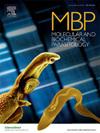Diversification of sphingolipid synthase activities in kinetoplastid protozoa
IF 1.4
4区 医学
Q4 BIOCHEMISTRY & MOLECULAR BIOLOGY
引用次数: 0
Abstract
Phosphosphingolipids (PSL) are essential components of eukaryotic membranes. The major PSL in fungi and protists is inositol phosphorylceramide (IPC), while sphingomyelin (SM), and to a lesser extent ethanolamine phosphorylceramide (EPC) predominate in mammals. Most kinetoplastid protozoa have a syntenic locus that encodes a single sphingolipid synthase (SLS) gene. Uniquely, among the kinetoplastids, the salivarian (African) trypanosomes have expanded this locus from a single gene in Trypanosoma vivax (TvSLS) to four genes in T. brucei (TbSLS1-4). We have previously shown that one of these is an IPC synthase, while the others are SM/EPC synthases, and that specificity is controlled by a single signature residue (IPC, serine; SM/EPC, phenylalanine). This residue is serine in T. cruzi and Leishmania major SLSs, both of which are demonstrated IPC synthases. However, T. vivax has a tyrosine at this residue raising the issue of specificity. Using a liposome-supplemented in vitro translation system we now show that T. vivax SLS is an SM/EPC synthase, and that the basal kinetoplastid Bodo saltans SLS is an IPC synthase (serine). We use these data, and a multiple alignment of available sequences, to discuss the evolution of kinetoplastid SLSs and their unique expansion in T. brucei and related salivarian trypanosomes.
原生动物内鞘脂合成酶活性的多样化
磷脂(PSL)是真核生物膜的重要组成部分。真菌和原生动物的主要磷脂是肌醇磷酰甘油酰胺(IPC),而哺乳动物的主要磷脂是鞘磷脂(SM),其次是乙醇胺磷酰甘油酰胺(EPC)。大多数动粒原生动物都有一个编码单一鞘脂合成酶(SLS)基因的同源基因座。与众不同的是,在动力原生动物中,唾液(非洲)锥虫将这一基因座从体内锥虫的单基因(TvSLS)扩大到布氏锥虫的四个基因(TbSLS1-4)。我们之前已经证明,其中一个基因是 IPC 合成酶,而其他基因是 SM/EPC 合成酶,特异性由一个标志性残基控制(IPC,丝氨酸;SM/EPC,苯丙氨酸)。在 T. cruzi 和利什曼原虫的 SLS 中,这个残基是丝氨酸,这两种原虫都被证明是 IPC 合成酶。然而,T. vivax 在这个残基上有一个酪氨酸,这就引起了特异性的问题。利用脂质体辅助体外翻译系统,我们现在证明间变性淋巴丝虫的 SLS 是 SM/EPC 合成酶,而基础动粒细胞的 Bodo saltans SLS 是 IPC 合成酶(丝氨酸)。我们利用这些数据以及现有序列的多重比对,讨论了动粒体 SLS 的进化及其在布氏锥虫和相关唾液锥虫中的独特扩展。
本文章由计算机程序翻译,如有差异,请以英文原文为准。
求助全文
约1分钟内获得全文
求助全文
来源期刊
CiteScore
2.90
自引率
0.00%
发文量
51
审稿时长
63 days
期刊介绍:
The journal provides a medium for rapid publication of investigations of the molecular biology and biochemistry of parasitic protozoa and helminths and their interactions with both the definitive and intermediate host. The main subject areas covered are:
• the structure, biosynthesis, degradation, properties and function of DNA, RNA, proteins, lipids, carbohydrates and small molecular-weight substances
• intermediary metabolism and bioenergetics
• drug target characterization and the mode of action of antiparasitic drugs
• molecular and biochemical aspects of membrane structure and function
• host-parasite relationships that focus on the parasite, particularly as related to specific parasite molecules.
• analysis of genes and genome structure, function and expression
• analysis of variation in parasite populations relevant to genetic exchange, pathogenesis, drug and vaccine target characterization, and drug resistance.
• parasite protein trafficking, organelle biogenesis, and cellular structure especially with reference to the roles of specific molecules
• parasite programmed cell death, development, and cell division at the molecular level.

 求助内容:
求助内容: 应助结果提醒方式:
应助结果提醒方式:


